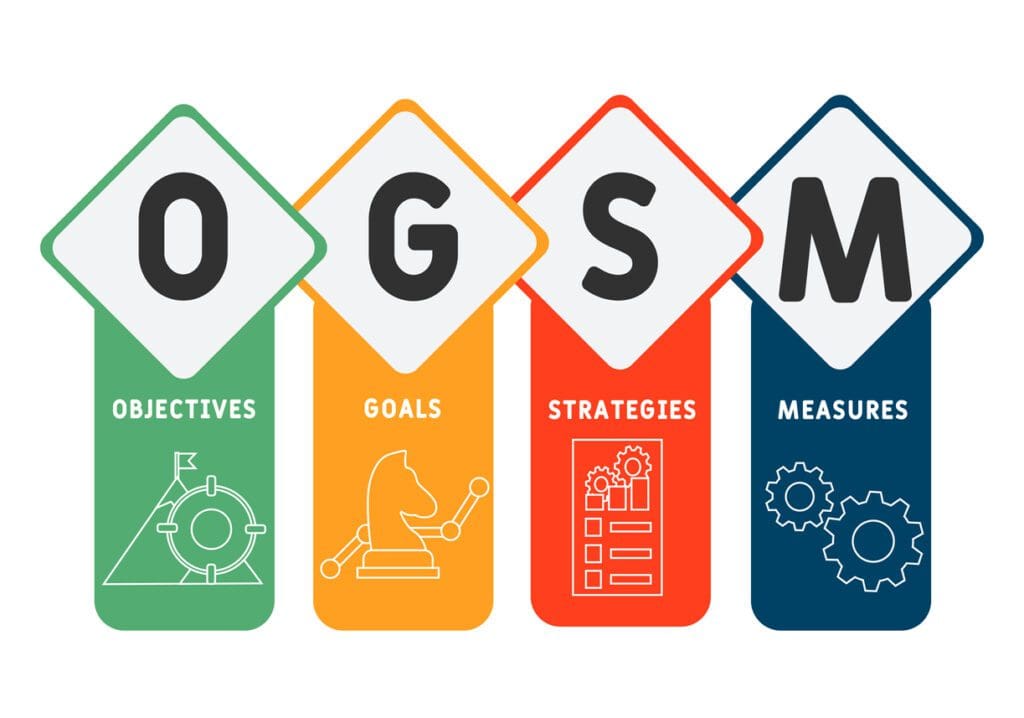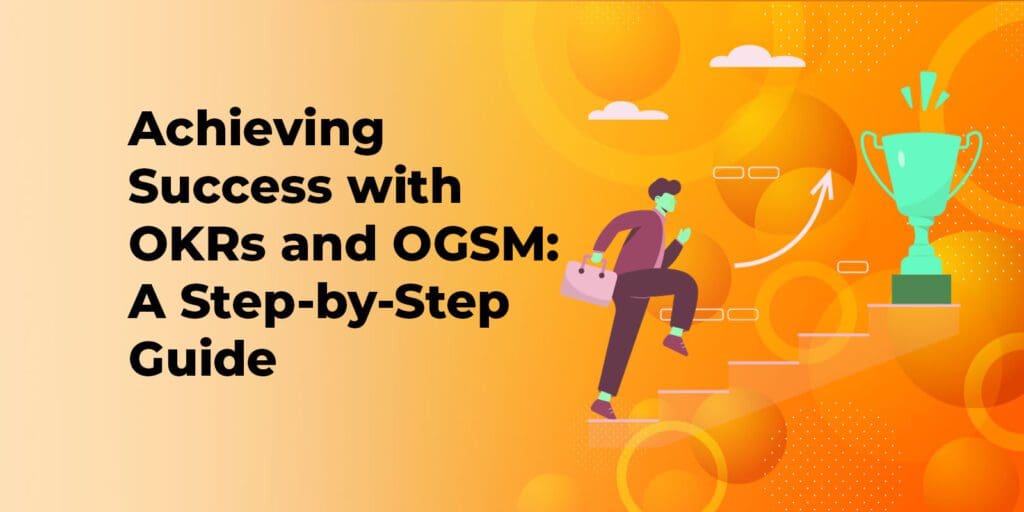Table of Contents
Achieving Success with OKRs and OGSM: A Step-by-Step Guide
Organisations that want to achieve long-term plans and goals must have a clear roadmap for success. In this article, we will discuss two popular methodologies commonly used for strategic planning: OKRs and OGSM. Organisations can achieve their long-term goals by understanding the difference between these two methodologies and how they can be utilised to set effective objectives and key results.
Understanding the difference between OKRs and OGSM
The primary difference between OKRs and OGSM lies in their goal-setting approach. OKRs methodology is based on identifying key objectives and results that need to be achieved in a specific time frame. This methodology is more focused on outcomes and results. OGSM, on the other hand, is a more comprehensive approach that includes specific goals, strategies, and measures required to achieve the objectives.
The benefits of using OKRs and OGSM for Strategic Planning
One of the significant benefits of using OKRs and OGSM is that it provides a clear roadmap for success. These methodologies help to align individual divisions with an organisation’s overall objectives, goals, and strategies. Organisations can achieve their long-term plans and goals by setting specific, measurable, achievable, and time-bound goals.
Another advantage of using OKRs and OGSM is that it promotes transparency, accountability, and collaboration. When everyone in the organisation works towards the same objectives and goals, it creates a culture of accountability and transparency. Additionally, OKRs and OGSM provide a framework for collaboration and communication, which helps ensure everyone is on the same page.
How to set effective objectives & key results? (OKRs)
Identifying the primary objective is the first step in setting effective objectives and key results. These objectives & key results should be specific, measurable, achievable, relevant, and time-bound.
It is essential to ensure that the objectives and key results are aligned with the organisation’s overall objectives, goals, and strategies. Additionally, it is crucial to ensure that the objectives and key results are challenging but achievable. If the objectives and key results are too easy, they will not motivate employees to work towards them. On the other hand, if they are too challenging, they can be demotivating and lead to employee burnout.
How to create specific, measurable, and time-bound goals, strategies, and measures (OGSM)?
One of the key challenges that managers and leaders face is creating specific, measurable, and time-bound goals, strategies, and measures (OGSM) for their department team. OGSM is a framework that helps organizations set clear objectives and key results (OKRs) and align them with their overall strategy. To create effective OGSM goals, it is important to start by defining your objective. This should be a clear, specific goal aligned with your organisation’s overall strategy. Next, you need to identify key results to help you achieve your objective.


These key results should be measurable and time-bound, so you can track progress and adjust as needed. Once you have identified your key results, developing strategies for achieving them is important. These strategies, which lay out the actions you must take to accomplish your main results, should be precise and doable.
Finally, you must create metrics to gauge your success and ensure you are on pace to meet your goals. These measures should be specific, measurable, and time-bound, so you can track your progress and adjust as needed. Following these steps, you can create effective OGSM goals to help your department team achieve their objectives and key results.
Tips for implementing OKRs and OGSM at the department and team level
One of the essential tips for implementing OKRs and OGSM at the department and team level is to ensure that the objectives, goals, and strategies are aligned with the organisation’s overall objectives, goals, and strategies. Additionally, it is crucial to ensure that the objectives, goals, and strategies are specific, measurable, achievable, relevant, and time-bound.
Another important tip is ensuring that everyone in the department or team knows the objectives, goals, and strategies. This can be achieved through regular meetings, communication, and collaboration. Additionally, it is essential to track progress towards achieving the objectives, goals, and strategies regularly.
Case Study: Comparison of the OGSM methodology with Coca-Cola’s strategic planning process
Coca-Cola’s strategic planning process is similar to the OGSM methodology. Coca-Cola’s strategic planning process includes specific objectives, goals, strategies, and measures required to achieve its long-term plans and goals. Between the two, the main distinction is that Coca-Cola’s strategic planning process is more comprehensive than OGSM.
Coca-Cola’s strategic planning process includes additional steps such as environmental analysis, competitor analysis, and SWOT analysis. These additional steps help ensure that the objectives, goals, and strategies are relevant and aligned with the external environment.


Conclusion: Why are OKRs and OGSM essential for any organisation striving for success?
In conclusion, OKRs and OGSM are essential methodologies for any organisation striving for success. These methodologies provide a clear roadmap for achieving long-term goals and promote transparency, accountability, and collaboration. Organisations can achieve their long-term plans and goals by setting specific, measurable, achievable, relevant, and time-bound objectives, goals, and strategies.
Sign up for free to execute your goal-planning strategy starting today!



